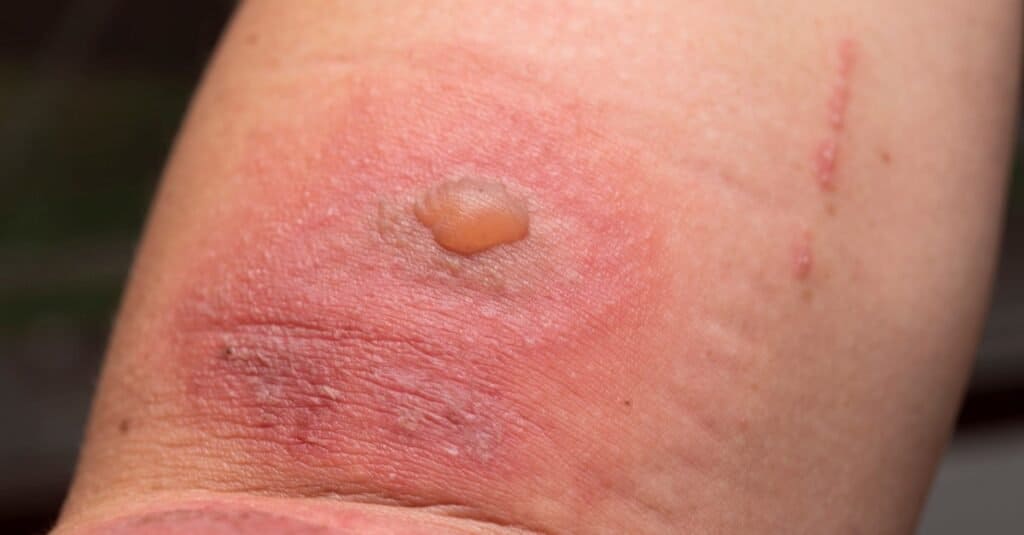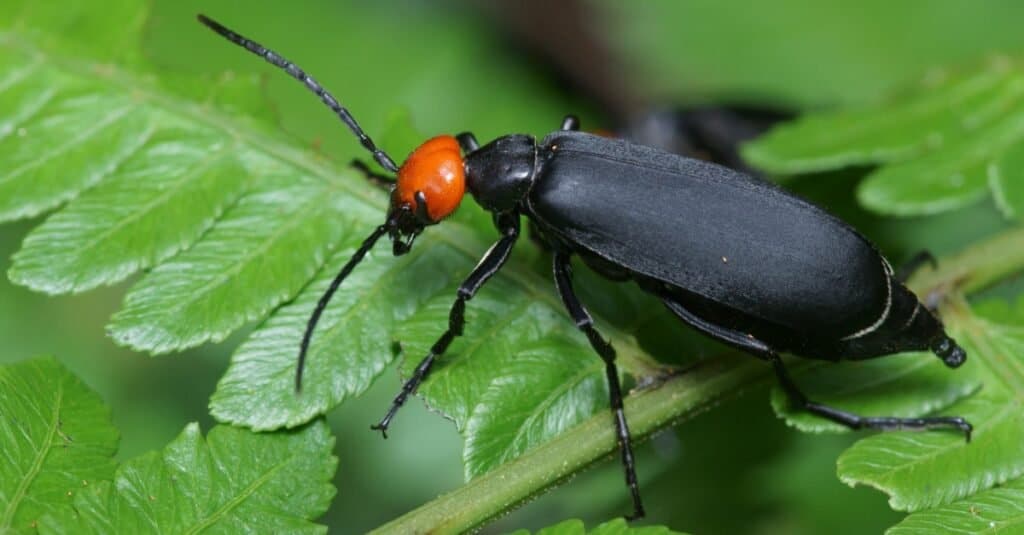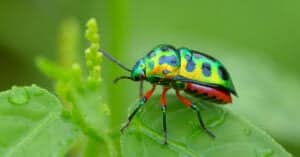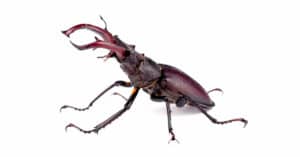Key Points
- Blister beetles are capable of growing up to an inch and can have bright colors of orange and yellow.
- They are generally disinterested in humans since their main focus is other flowers and leaves to snack on.
- They do not bite but release a potent toxin when they feel threatened. Though painful, the resulting swelling will heal with time without leaving any scars behind.
The blister beetle is a family of toxic insects that live all around the world and cause skin damage to people upon making contact. With some 7,500 known species, their appearance varies widely in many different shapes and sizes, but most of them are swathed in bright yellow or orange colors and measure up to an inch long. They feed on other insects as larvae and then switch to a diet heavy in flowers or leaves as an adult. When threatened, these beetles have the ability to secrete a painful blistering substance called cantharidin from their joints. This makes predators think twice before attacking them. Humans are not normally the targets of their aggression, but if you disturb them, then they will respond with their defensive measures. This article will cover everything you need to know in order to properly treat the wound, including some important information about the symptoms and signs of the blister.
How to Identify the Symptoms of a Blister Beetle

©Kittibowornphatnon/Shutterstock.com
People often harbor some very large misconceptions about how the blister beetle causes skin damage. The truth is that symptoms are rarely caused by the actual bites. The jaws are generally not powerful enough to puncture the skin and draw blood. The blister beetle also does not have a stinger to deliver its toxin. Instead, the worst effects come from a caustic (meaning acidic) substance called cantharidin that it secretes directly from the joints of its body when directly threatened by another animal. If you experience symptoms, then it’s almost certainly not because it bit you.
When it makes direct contact with the skin, this caustic substance will induce significant pain, irritation, and redness. You may also notice signs of a large welt or blister developing on your skin. The welt looks just like a red patch of raised skin, while the blister is a large pocket of fluid or pus. The reaction usually develops over the course of one or two days after initial contact with the skin. The good news is that the cantharidin does not cause any systemic or body-wide effects. The symptoms of the toxin should be limited to the immediate area of the skin where it made contact. If you have recently come into contact with a blister beetle, then you should monitor the affected area for signs of any skin damage.
Treatment of Blister Beetle Symptoms
The symptoms of blister beetle should go away without much intervention after about a week. They will leave behind no permanent scarring or marks. However, there are a few things you can do to speed up recovery. The best thing you can do is to apply cold compression and topical steroids or creams (specially designed for blisters) several times a day on the affected area to improve the swelling and pain. You should also wash the blister every day with warm soap and water to prevent it from developing an infection.
The blister is rarely serious enough to see a doctor unless you develop a secondary infection or get some of the cantharidin in your eye. If an infection does occur, then your doctor may prescribe some antibiotics to deal with it. During the appointment, you should bring a list of medications and a detailed description of how you obtained your blister.

©Suede Chen/Shutterstock.com
Prevention of Blister Beetle Symptoms
Blister beetles should be fairly easy to avoid because they do not normally infest the home. But when you’re outdoors during the summer, you should be careful around common blister beetle locations, including flower beds, light fixtures, and grassy fields. It’s a good idea to wear a long-sleeved shirt and pants so the beetle doesn’t make direct contact with your skin. If one happens to land on you, then the last thing you should do is crush it, because this will release its caustic substance onto your skin. Instead, you should gently blow it off or wipe it away, and then immediately wash any clothing that has come into contact with the blister beetle. If it has come into direct contact with your skin, then wash the area with water and soap immediately. This should help with the prevention of any symptoms.
Up Next…
Keep reading these posts for more incredible information about key animal facts.
- How to Get Rid of Squash Beetles: They can pose a risk to pumpkin and squash plants. Find out how to get rid of them and raise healthy crops free of their ravenous menace.
- Stag Beetle Insect Facts: Its characteristic mandibles reminiscent of a stag’s antlers sets it apart from other arthropods. Discover more intriguing facts about this adaptable beetle here.
- Hercules Beetle Insect Facts: One of the world’s largest insects, it’s capable of defying gravity in spite of its size. Read about what else it’s capable of too, in this post.
The photo featured at the top of this post is © iStock.com/PhotoSparks
FAQs (Frequently Asked Questions)
Should I pop blister beetle bites?
As annoying as the blister might be, it is not a good idea to pop it. If you just leave it alone, then the blister will go away after a week with no permanent problems. The main reason to let it heal on its own is that an untouched blister is unlikely to develop an infection. If you pop a blister, however, then you are exposing the pus-filled interior to bacteria. This greatly increases the chance that it will develop an infection, which will complicate your treatment. If you do intend to pop it, then you may want to peel away the skin, sterilize the area with rubbing alcohol, and then apply some ointment and a bandage.
How do you treat beetle bites?
The most common treatment for the blister beetle is to apply cold compression or cream to the affected area. You should also wash the area with water and soap to prevent secondary infection.
When do blister beetles come out?
Blister beetles are most active during the summer months, especially when the height of the breeding season approaches. That is when you are most likely to accidentally come into contact with the beetles.
How do you identify blister beetles?
The adult blister beetle can be identified by its conspicuous appearance. They have bright orange, yellow, and red markers or spots covering the otherwise black body, which usually serve the purpose of warning away potential predators. Many of them also have long bodies that measure up to an inch in size. When they draw back their wing covers, they also have the ability to fly. The larvae, by contrast, look like big white worm-like grubs, and they are unable to produce toxins. Recognizing the correct appearance can help with the prevention of symptoms.
Where are blister beetles located?
Blister beetles can be found all over the world except for the most extreme cold climates. They prefer to live around grasslands, forests, gardens, and farms. Many of them are dedicated agricultural pests that feed on vegetable crops, ornamental plants, and hay. When this hay is processed, the beetle and its toxins can be ground up in it. This poses a danger to any animal that eats the hay. Horses, sheep, and other livestock are particularly vulnerable to the caustic substance, potentially resulting in their deaths. Blister beetles also otherwise cause immense economic damage every year with their feeding patterns.
Thank you for reading! Have some feedback for us? Contact the AZ Animals editorial team.






